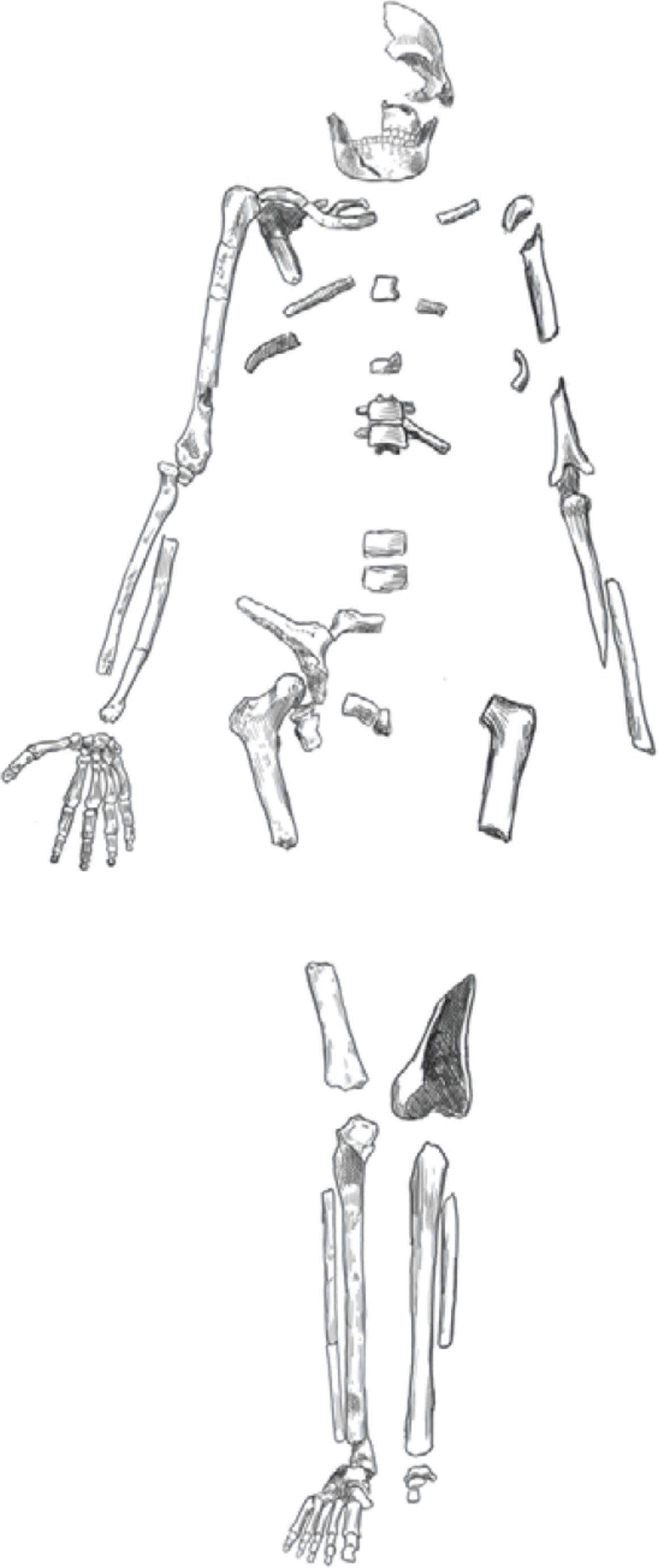29
As the workshop ended, our teams were busy preparing manuscripts describing the fossils, the new species, and its geological context. This work would take many months of writing, revision, and review by other experts outside our team before the first parts were ready to publish. Initially, we decided to send an entire package of papers to the journal Nature, a traditional home for such studies. Nature had published the first description of the Taung Child, the first description of Homo habilis, and many other historic studies. It seemed a natural place.
But this was not meant to be. We sent a series of papers describing the Dinaledi fossils, all in support of the work defining Homo naledi and describing the geological context of the cave. We wanted to show that the proposed new species was supported by detailed work on anatomy across the entire skeleton. This would be a reversal of the usual approach, in which scientists describe a new species in a very short paper and only much later provide greater detail.
Apparently we took this new approach a step too far. The referees of the papers agreed that the fossils were important, but there were too many papers. Through several months of back-and-forth communications with the editor, we found that we could not find a way to publish our team’s work in Nature. The editors fundamentally disagreed with us about the scope and scale of the reporting needed to describe this immense new collection scientifically.
Through my entire career, I have advocated for broader access to fossils. It was my early instinctive response to what I found to be a clique—a small international coterie of fossil discoverers who involved only a handful of experts in their work and talked mainly to each other. Scientists outside this group often struggled for the most basic access to data, which prevented them from doing their best possible work—a situation I deplored.
But many established paleoanthropologists acted as if open access would endanger the resources they needed to carry out their work. When I had first opened up access to the Sterkfontein fossils—now more than 15 years ago—other paleoanthropologists had strongly objected. With the sediba discovery, and now with naledi, our team was acting on the principle that open access empowered us, bringing hundreds of researchers and their resources from around the world to South Africa. Ensuring open access to the fossils has empowered the South African government to invest in the science of paleoanthropology, recognizing it as an area of scientific strength unique to the nation. The work has enabled development of the local community around the sites for tourism and support of the science, and it has given scientists the tools to make good decisions about the way forward.
Reflecting on this, we decided to do something unprecedented. We submitted our first papers describing the Rising Star fossils to eLife, a relatively new scientific journal that followed an open-access policy, matching the ethic that we had developed for the fossil remains themselves. Our papers would total more than 70 pages, providing six times as much supporting information as most previous papers that had described new hominin fossil discoveries. After a rigorous and collaborative review process, the papers would be published on September 10, 2015—not quite two years after Steven and Rick first went down the Chute and found fossil bones scattered on the cave floor.
We could watch the impact of our decision to publish our findings online. In days, more than 100,000 people around the world had viewed or downloaded the scientific papers describing the discovery; over the next few months, that number grew to more than 250,000. Over the next year, the number of views and downloads topped 325,000, according to eLife’s own metrics.
In another unusual move, we released our scans of the fossils simultaneously. We were able to take open access to the fossils another step beyond what we had done for sediba, thanks to a new initiative from Duke University called MorphoSource, a website that archives data from skeletons and fossil specimens in a format that can drive three-dimensional printers. As soon as our team uploaded the data from laser scans of key Rising Star fossils to the site, our scientific colleagues and teachers around the world started downloading them. It had never happened before—almost immediately, as soon as the fossils were announced, people around the world were using 3-D printers to create and examine their own copies of them.
This kind of open access to scientific data has become common in other fields of science. Geneticists share DNA sequences even before they publish papers based on the data, and astronomers share data from telescopes and other instruments. But in the study of human evolution, this approach had never been attempted on such a scale.
With the announcement of naledi, not only the new species but also the open access to the science won high praise and much attention, all the way up to the highest levels. At the press conference announcing the papers, our team was joined by the deputy president of South Africa, Cyril Ramaphosa, who praised the extraordinary teamwork and skills that enabled us to carry out the challenging work and our team’s commitment to open access. As he put it, these discoveries about our ancient fossil relatives help establish the scientific basis of our common humanity.



Reconstruction of the skeleton of Homo naledi. The different fossils here probably come from several different individuals.
OVER THE NEXT FEW weeks and months, I proudly watched as casts of Homo naledi went up on display in museums across the world. At Maropeng, the visitors center for the Cradle of Humankind World Heritage site, the university worked with the government to enable the original naledi fossils—hundreds of them—to go on public display. People in South Africa—families, school classes, and tourists from around the world—flocked to see this new human relative. When it was time for the fossils to return to the secure vault at the university, the museum organized a farewell concert. Around the world, more and more people were learning the story of our underground explorers and pondering the mystery of the Dinaledi Chamber. Humanity had met a new species of human relatives, and all embraced it.
Our team had seen many transitions. Six of our workshop scientists had new babies. One of the underground astronauts, Lindsay Eaves, had fallen in love and married one of the cavers, Rick Hunter, and soon they were expecting a child of their own. Others finished their Ph.D. degrees and moved on into postdoctoral or tenure-track positions. Marina Elliott, Ph.D. completed, relocated to South Africa to head the exploration team, continuing her work underground in the Rising Star cave system. The National Research Foundation recognized the entire team with their second ever award for “Team Science.” All in all, Rising Star had been good to everyone.

HOW DID NALEDI CHANGE the story of human evolution?
As with sediba, our first publication on naledi was not an end but a beginning of many new lines of research. There was so much left to do.
One thing dominated our thinking as we digested the research we had accomplished already: These two samples from Malapa and Dinaledi combined gave us better evidence across the entire skeleton than any other fossil samples that we could compare them with. Only when we got to archaic humans, like Neanderthals, did we have a full enough fossil record to see the anatomy of our relatives so well.
In a lot of ways, naledi seemed like a logical step in a humanlike direction from sediba. Both of these species had small brains, australopith-like in size, but the naledi skull was shaped more like the skull of Homo erectus, with teeth that seemed more like those of erectus, habilis, and even archaic humans. That much was clear. Sediba had a primitive foot and leg; naledi was humanlike. Sediba was more humanlike in its wrist anatomy than habilis, but naledi’s hand was almost entirely like a human’s, except for those curved fingers. There were some exceptions. In sediba, the hips were more like humans’; in naledi, they were more primitive, like those of the early hominins that stood and walked upright.
Five years after we had described the Malapa finds, more and more scientific work had confirmed our original idea that Australopithecus sediba was a close relative of Homo. Now, the Dinaledi fossils showed us a new hominin species—another form of Homo that seemed very close to what that ancestral form might have been.
But was it? Our scientific colleagues around the world wanted to know one thing more than anything else. How old were the fossils?
We were about to find out.